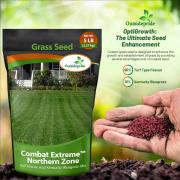Looking to overseed my personal lawn this fall. Northern Indiana. Lawn is a sunny mix of KBG, rye,
creeping red fescue and maybe another fescue mixed in. Live by on a big sand hill. It’s terrible for
heat stress and fungus. I’ve heard many of you talk about higher quality seed. What are some of the best options?
creeping red fescue and maybe another fescue mixed in. Live by on a big sand hill. It’s terrible for
heat stress and fungus. I’ve heard many of you talk about higher quality seed. What are some of the best options?






